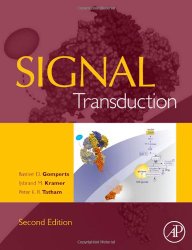Engineering Bookshelf
- Aerospace
- Biological
- Civil
- Chemical
- Environmental
- Electrical
- Materials
- Mechanical
- Petroleum
- Geoengineering
- Software

Signal Transduction
by Bastien Gomperts, Ijsbrand M. Kramer, Peter E. R. Tatham, Bastien D. Gomperts, Ijsbrand Kramer, Peter TathamPublisher: Academic Press
ISBN: 0123694418
Check price @ amazon.com , amazon.ca , amazon.co.uk
Book Description
Signal Transduction, 2e, is a thorough, well-illustrated study in cellular signaling processes. Beginning with the basics, this book shows how cells respond to external cues, hormones, growth factors, cytokines, cell surfaces, etc., and further instructs how these inputs are integrated. Instruction continues with up-to-date, inclusive coverage of intracellular calcium, nuclear receptors, tyrosine protein kinases and adaptive immunity, and targeting transduction pathways for research and medical intervention. Signal Transduction, 2e, serves as an invaluable resource for advanced undergraduates, graduate researchers, and established scientists working in cell biology, pharmacology, immunology, and related fields.
- Up-to-date, inclusive coverage of targeting transduction pathways for research and medical intervention
- In-depth coverage of nuclear receptors, including steps in isolation of steroid hormones and the discovery of intracellular hormone receptors; tyrosine protein kinases and adaptive immunity; and intracellular calcium
- Extensive conceptual color artwork to assist with comprehension of key topics
- Instrumental margin notes highlight milestones in signaling mechanisms
Signal Transduction is a well-illustrated, coherent look at cellular signaling processes. Beginning with the basics, it explains how cells respond to external cues, hormones, growth factors, cytokines, cell surfaces, etc., and then shows how these inputs are integrated and coordinated. The extensive color artwork provides the reader with a clearer comprehension of key topics, and margin notes are incorporated to highlight milestones in the evolution of signal transduction. This book serves as an invaluable resource for advanced undergraduates, graduate researchers, and established scientists working in cell biology, pharmacology, immunology, and related fields.
Key Features:
- Coherent, precise text providing insight in depth to a subject that is central to cell biology and fundamental to many areas of biomedicine
- Extensive conceptual colour artwork assists with the comprehension of key topics
- Extensive referencing provides an invaluable link to the core and historical literature
- Margin notes highlighting milestones in the evolution of our understanding of signalling mechanisms
Book Info
Univ. College London, UK. First half of text provides the nuts and bolts of what might be termed 'classical' signal transduction and concentrates on hormones, their receptors, and the generation and actions of second messengers. Second half covers transduction processes set in action by growth factors and adhesion molecules. Color illustrations.
About the Author
Bastien Gomperts, University College, London, United Kingdom
Ijsbrand M Kramer, University of Bordeaux, Talence, France
Peter E.R. Tatham, University College, London, United Kingdom
Customer Reviews
A reader from Chicago, IL United States
5 stars - give me a break, that book hasn't been written yet! By comparison with the other [stuff]hat's out there, like the abysmal Hancock book from a few years ago or the equally execrable Helmreich text, this one DOES stand out like a overexpressed GFP-kinase. One thing that is definitely better is the illustrations (not credited remarkably enough) most of which are well done. It is a pretty good undergrad text and I used it in a course to generally good reviews. The format is entirely conventional, however, and follows a predictable sequence. One is not going to learn much new, if already in the field. Old Gomp et al do get nostalgic with their historical sidelines and overdo it in some places - e.g. the abstruse tale of who really discovered insulin - but in general the use of sidebars (very reminiscent of the new Nature review journals in format) is well done.
There are several problems that are difficult to work out in teaching signalling to undergrads these days. One is how to incorporate enough physiology of specific organs such that the tissue-specific signalling that makes them work is comprehensible. Another is how to incorporate the newer structural information so that it actually adds to understanding, as opposed to being just a superficial take on structural biology. I don't think the text solves either of these problems particularly well, but it does make a worthwhile stab at it.
All in all a good buy. One awaits the paperback so that the [money]tag is not such a hurdle to purchase.
Michael B. Yaffe from Cambridge, MA United States
Anyone who has surveyed the collection of existing textbooks on signal transduction realizes that they come in two basic flavors - those that cover alot of ground in an extremely superficial fashion, and those that delve in depth into a few narrow area while leaving vast tracts of the subject untouched. In addition, most texts are written on a chapter-by-chapter basis by different authors, leaving these texts more a collection of essays than a comprehensive review.
Gomperts, Kramer and Tatham's book has suceeded dramatically where most of the others have failed. The text is strikingly comprehensive, covering nearly all major areas of signal transduction including receptors, G proteins, calcium signaling, protein and lipid kinases and phosphatases, growth factors and cell adhesion. It is the first book I have seen that integrates historical, pharmacological, and physiological findings in these areas with the biochemistry and fine molecular detail of the molecules involved. Written with a single voice, the chapters integrate elegantly with one another, and provide the reader with both broad and comprehensive viewpoints - one sees the forest AND the trees! Remarkably current and up-to-date, the book promises to be a core text for graduate and advanced undergraduate courses in cell signaling and molecular cell biology, and a valuable reference book for all scientists whose work involves mechanisms of cell communication.